The Green Infrastructure in Cities as A Tool for Climate Change Adaptation and Mitigation: Slovakian and Polish Experiences
Abstract
1. Introduction
2. Materials and Methods
2.1. Study Areas
2.1.1. Bratislava
2.1.2. Wrocław
2.2. Materials
2.3. Methods
3. Recent Experience in Green Areas and Green Infrastructure Development: Bratislava and Wrocław Case Studies
3.1. Bratislava Experiences in Green Areas Development
Bratislava Local Legal Regulations and Funds for Green Projects Realization
3.2. Wrocław Experiences in Green Areas and Infrastructre Implementation
Wrocław Local Legal Regulations and Funds for Green Projects Realization
4. Results
4.1. Bratislava–The Implementation of Green Projects for Climate Change Adapttaion and Mittigation
4.2. Wrocław–The Implementation of Green Projects for Climate Change Adapttaion and Mittigation
4.3. Bratislava vs. Wrocław—The Comparision
5. Discussion and Conclusions
Author Contributions
Funding
Acknowledgments
Conflicts of Interest
References
- Howell, L. Global Risks Report 2013, 8th ed.; World Economic Forum: Cologny/Geneva, Switzerland, 2013. [Google Scholar]
- Hoegh-Guldberg, O.; Jacob, D.; Taylor, M.; Bindi, M.; Brown, S.; Camilloni, I.; Diedhiou, A.; Djalante, R.; Ebi, K.; Engelbrecht, F.; et al. Impacts of 1.5 °C Global Warming on Natural and Human Systems. In Global Warming of 1.5 °C. An IPCC Special Report on the Impacts of Global Warming of 1.5 °C above Pre-Industrial Levels and Related Global Greenhouse Gas Emission Pathways, in the Context of Strengthening the Global Response to the Threat of Climate Change; Masson-Delmotte, V., Zhai, P., Pörtner, H.-O., Roberts, D., Skea, J., Shukla, P.R., Pirani, A., Moufouma-Okia, W., Péan, C., Pidcock, R., et al., Eds.; IPCC: Geneva, Switzerland, 2018; pp. 186–209. [Google Scholar]
- Gould, G.K.; Liu, M.; Barber, M.E.; Cherkauer, K.A.; Robichaud, P.R.; Adam, J.C. The effects of climate change and extreme wildfire events on runoff erosion over a mountain watershed. J. Hydrol. 2016, 536, 74–91. [Google Scholar] [CrossRef]
- Flannigan, M.D.; Amiro, B.D.; Logan, K.A.; Stocks, B.J.; Wotton, B.M. Forest fires and climate change in the 21ST century. Mitig. Adapt. Strateg. Glob. Chang. 2006, 11, 847–859. [Google Scholar] [CrossRef]
- United Nations Environment. Global Environment Outlook—GEO-6: Healthy Planet, Healthy People, 1st ed.; University Printing House: Cambridge, UK, 2019. [Google Scholar]
- Śpitalniak, M.; Lejcu, K.; Dąbrowska, J.; Garlikowski, D.; Bogacz, A. The Influence of a Water Absorbing Geocomposite on Soil Water Retention and Soil Matric Potential. Water 2019, 11, 1731. [Google Scholar] [CrossRef]
- Jadhav, P.P.; Ranveer, A.C. Human Population and Environment: Effects of Population Growth, Climate Changes and Poverty Relationship. Online Int. Interdiscip. Res. J. 2016, VI, 54–60. [Google Scholar]
- Solecka, I.; Sylla, M.; Świąder, M. Urban Sprawl Impact on Farmland Conversion in Suburban Area of Wroclaw, Poland. In IOP Conference Series: Materials Science and Engineering; IOP Publishing: Bristol, UK, 2017; Volume 245. [Google Scholar] [CrossRef]
- Świąder, M.; Szewrański, S.; Kazak, J.; van Hoof, J.; Lin, D.; Wackernagel, M.; Alves, A. Application of Ecological Footprint Accounting as a Part of an Integrated Assessment of Environmental Carrying Capacity: A Case Study of the Footprint of Food of a Large City. Resources 2018, 7, 52. [Google Scholar] [CrossRef]
- Dubbeling, M.; Carey, J.; Hochberg, K. The Role of Private Sector in City Region Food Systems; Analysis Report; Global Partnership on Sustainable Urban Agriculture and Food Systems: Rotterdam, The Netherlands, 2016. [Google Scholar]
- Hill, J.; Mustafa, S. Natural Resources Management and Food Security in the Context of Sustainable Development. Sains Malays. 2011, 40, 1331–1340. [Google Scholar]
- The Climate Mobilization Cities and Local Governments across the Planet That Have Declared a Climate Emergency. Available online: https://www.theclimatemobilization.org/world-map (accessed on 26 July 2019).
- European Commission. Communication from the Commission to the European Parliament, the Council, the European Economic and Social Committee and the Committee of the Regions; Environmental Implementation Review 2019: A Europe That Protects Its Citizens and Enhances Their Quality of Life; European Economic and Social Committee and the Committee of the Regions: Brussels, Belgium, 2019. [Google Scholar]
- European Parliament. Decision No 1386/2013/EU of the European Parliament and of the Council of 20 November 2013 on a General Union Environment Action Programme to 2020 ‘Living Well, within the Limits of Our Planet’; European Parliament: Brussels, Belgium, 2013. [Google Scholar]
- Szewrański, S.; Świąder, M.; Kazak, J.K.; Tokarczyk-Dorociak, K.; van Hoof, J. Socio-Environmental Vulnerability Mapping for Environmental and Flood Resilience Assessment: The Case of Ageing and Poverty in the City of Wrocław, Poland. Integr. Environ. Assess. Manag. 2018, 14, 592–597. [Google Scholar] [CrossRef]
- 100RC 100 Resilient Cities. Available online: http://www.100resilientcities.org/about-us/ (accessed on 29 August 2019).
- C40 Cities Climate Leadership Group. Available online: http://www.c40inclusivecities.org/ (accessed on 23 March 2017).
- C40 Cities We Live Here Together. Available online: http://www.c40inclusivecities.org/ (accessed on 27 July 2019).
- Satterthwaite, D.; Pelling, M.; Reid, H.; Lanko, P.R. Adapting to Climate Change in Urban Areas: The Possibilities and Contrains in Low- and Middle-Income Nations; IIED: London, UK, 2007; ISBN 9781843696698. [Google Scholar]
- Reckien, D.; Flacke, J.; Olazabal, M.; Heidrich, O. The Influence of Drivers and Barriers on Urban Adaptation and Mitigation Plans-An Empirical Analysis of European Cities. PLoS ONE 2015, 10, e0135597. [Google Scholar] [CrossRef]
- IPCC. Scoping of the IPCC Sixth Assessment Report (AR6). Background, Cross Cutting Issues and the AR6 Synthesis Report; IPCC: Geneva, Switzerland, 2017. [Google Scholar]
- Carter, J.G.; Cavan, G.; Connelly, A.; Guy, S.; Handley, J.; Kazmierczak, A. Climate change and the city: Building capacity for urban adaptation. Prog. Plan. 2015, 95, 1–66. [Google Scholar] [CrossRef]
- Vincent, K.; Colenbrander, W. Developing and applying a five step process for mainstreaming climate change into local development plans: A case study from Zambia. Clim. Risk Manag. 2018, 21, 26–38. [Google Scholar] [CrossRef]
- Mayer, A.L.; Shuster, W.D.; Beaulieu, J.J.; Hopton, M.E.; Rhea, L.K.; Roy, A.H.; Thurston, H.W. Building Green Infrastructure via Citizen Participation: A Six-Year Study in the Shepherd Creek (Ohio). Environ. Rev. Case Stud. 2012, 14, 57–67. [Google Scholar]
- Haq, S.M.A. Urban Green Spaces and an Integrative Approach to Sustainable Environment. J. Environ. Prot. 2011, 2, 601–608. [Google Scholar] [CrossRef]
- Capasso, M.; Hansen, T.; Heiberg, J.; Klitkou, A.; Steen, M. Green growth—A synthesis of scientific findings. Technol. Forecast. Soc. Chang. 2019, 146, 390–402. [Google Scholar] [CrossRef]
- Ghofrani, Z.; Sposito, V.; Faggian, R. A Comprehensive Review of Blue-Green Infrastructure Concepts. Int. J. Environ. Sustain. 2017, 6. [Google Scholar] [CrossRef]
- Sturiale, L.; Scuderi, A. The evaluation of green investments in urban areas: A proposal of an eco-social-green model of the city. Sustainability 2018, 10, 4541. [Google Scholar] [CrossRef]
- Mladenović, E.; Lakićević, M.; Pavlović, L.; Hiel, K.; Padejčev, J. Opportunities and Benefits of Green Balconies and Terraces in Urban Conditions. Contemp. Agric. 2018, 66, 38–45. [Google Scholar] [CrossRef]
- Naumann, S.; Kaphengst, T.; McFarland, K.; Stadler, J. The Challenge of Climate Change-Partnering with Nature. Nature-Based Approaches for Climate Change Mitigation and Adaptation; Ecologic Institute: Bonn, Germany, 2014. [Google Scholar]
- Depietri, Y.; McPhearson, T. Integrating the Grey, Green, and Blue in Cities: Nature-Based Solutions for Climate Change Adaptation and Risk Reduction. In Nature-Based Solutions to Climate Change Adaptation in Urban Areas; Kabish, N., Korn, H., Stadler, J., Bonn, A., Eds.; Springer: Cham, Switzerland, 2017; pp. 91–109. [Google Scholar]
- Zolch, T.; Wamsler, C.; Pauleit, S. Integrating the ecosystem-based approach into municipal climate adaptation strategies: The case of Germany. J. Clean. Prod. 2018, 170, 966–977. [Google Scholar] [CrossRef]
- Coutts, C.; Hahn, M.; Coutts, C.; Hahn, M. Green Infrastructure, Ecosystem Services, and Human Health. Int. J. Environ. Res. Public Health 2015, 12, 9768–9798. [Google Scholar] [CrossRef]
- Sylla, M.; Lasota, T.; Szewrański, S. Valuing Environmental Amenities in Peri-Urban Areas: Evidence from Poland. Sustainability 2019, 11, 570. [Google Scholar] [CrossRef]
- Vargas-Hernández, J.G.; Pallagst, K.; Zdunek-Wielgołaska, J. Urban Green Spaces as a Component of an Ecosystem. In Handbook of Engaged Sustainability; Springer International Publishing: Cham, Switzerland, 2018; pp. 1–32. [Google Scholar]
- Gehl, J. Cities for People, 1st ed.; Island Press: Washington-Covelo-London, UK, 2010. [Google Scholar]
- Balfour, R.; Jessica, A. Local Action on Health Inequalities: Improving Access to Green Spaces; Public Health England, UCL Institute of Health Equity: London, UK, 2014. [Google Scholar]
- Pauleit, S.; Zolch, T.; Hansen, R.; Randtrup, T.B.; Konijnendijk van den Bosch, C. Nature-Based Solutions to Climate Change Adaptation in Urban Areas. Theory and Practice of Urban Sustainability Transitions; Springer: Cham, Switzerland, 2017. [Google Scholar]
- Anguluri, R.; Narayanan, P. Role of green space in urban planning: Outlook towards smart cities. Urban For. Urban Green. 2017, 25, 58–65. [Google Scholar] [CrossRef]
- Derkzen, M.L.; van Teeffelen, A.J.A.; Verburg, P.H. Green infrastructure for urban climate adaptation: How do residents’ views on climate impacts and green infrastructure shape adaptation preferences? Landsc. Urban Plan. 2017, 157, 106–130. [Google Scholar] [CrossRef]
- Végétalisons la ville. Available online: http://www.paris.fr/duvertpresdechezmoi (accessed on 12 July 2019).
- TARGET 100 HECTARES. Available online: http://www.parisculteurs.paris/fr/charte-100-hectares/ (accessed on 12 July 2019).
- Permis de Végétaliser. Available online: https://teleservices.paris.fr/k10/jsp/site/Portal.jsp?page=form&id_form=14/ (accessed on 12 July 2019).
- Cities 100. Available online: https://issuu.com/sustainia/docs/sustainia100_2016 (accessed on 12 July 2019).
- PWC. Wrocław. A City with Prospects; PWC: Warsaw, Poland, 2015. [Google Scholar]
- PWC; Slovakia, P.C.R. Business Service Centres: Top Performance Drivers Major Drivers of Changes in the BSC Sector-Key Data and Trends; PWC: Bratislava, Slovakia; Prague, Czech Republic, 2017. [Google Scholar]
- Tokarczyk-Dorociak, K.; Kazak, J.; Szewrański, S. The Impact of a Large City on Land Use in Suburban Area—the Case of Wrocław (Poland). J. Ecol. Eng. 2018, 19, 89–98. [Google Scholar] [CrossRef]
- Šveda, M.; Barlík, P. Daily commuting in the Bratislava metropolitan area: Case study with mobile positioning data. Pap. Appl. Geogr. 2018, 4, 409–423. [Google Scholar] [CrossRef]
- Kaklauskas, A.; Zavadskas, E.K.; Radzeviciene, A.; Ubarte, I.; Podviezko, A.; Podvezko, V.; Kuzminske, A.; Banaitis, A.; Binkyte, A.; Bucinskas, V. Quality of city life multiple criteria analysis. Cities 2018, 72, 82–93. [Google Scholar] [CrossRef]
- Bratislava Municipality. Territorial Plan of the Capital City Bratislava [Org.Územný Plán Hlavného Mesta Slovenskej Republiky Bratislavy]; Bratislava Magistrát: Bratislava, Slovakia, 2007. [Google Scholar]
- Štatistický Úrad Slovenskej Republiky. Statistical Yearbook of the Bratislava City (Org. Štatistická Ročenka Hlavného Mesta SR Bratislavy); Štatistický Úrad Slovenskej Republiky: Bratislava, Slovakia, 2017. [Google Scholar]
- Slovenský Hydrometeorologický Ústav Climatic Conditions [Org. Klimatické Pomery]. Available online: http://www.shmu.sk/sk/?page=1064 (accessed on 10 July 2019).
- Slovenský Hydrometeorologický Ústav Meteorological alerts [Org. Meteorologické Výstrahy]. Available online: www.shmu.sk (accessed on 10 July 2019).
- Magistrát Hlavného Mesta SR Bratislavy. The Strategy on Adaptation to Negative Effects of Climate Change within the Territory of Bratislava the Capital of the Slovak Republic [Org. Stratégia Adaptácie na Nepriaznivé Dôsledky Zmeny Klímy na Území hl. Mesta SR Bratislavy]; Magistrát Hlavného Mesta SR Bratislavy: Bratislava, Slovakia, 2014. [Google Scholar]
- Magistrát Hlavného Mesta SR Bratislavy. Action Plan for Adaptation to Climate Change in Bratislava 2017–2020 [Org. Akčný Plán Adaptácie na Nepriaznivé Dôsledky Zmeny Klímy na Území Hlavného Mesta SR Bratislavy na Roky 2017–2020]; Magistrát Hlavného Mesta SR Bratislavy: Bratislava, Slovakia, 2017. [Google Scholar]
- Świąder, M.; Szewrański, S.; Kazak, J.K. Foodshed as an example of preliminary research for conducting environmental carrying capacity analysis. Sustainability 2018, 10, 882. [Google Scholar] [CrossRef]
- Tokarczyk-Dorociak, K.; Walter, E.; Kobierska, K.; Kołodynski, R. Rainwater management in the urban landscape of Wroclaw in terms of adaptation to climate changes. J. Ecol. Eng. 2017, 18, 171–184. [Google Scholar] [CrossRef]
- Szewrański, S.; Kazak, J.; Żmuda, R.; Wawer, R. Indicator-Based Assessment for Soil Resource Management in the Wrocław Larger Urban Zone of Poland. Polish J. Environ. Stud. 2017, 26, 2239–2248. [Google Scholar] [CrossRef]
- Kazak, J.K. The Use of a Decision Support System for Sustainable Urbanization and Thermal Comfort in Adaptation to Climate Change Actions—The Case of the Wrocław Larger Urban Zone (Poland). Sustainability 2018, 10, 1083. [Google Scholar] [CrossRef]
- Sówka, I.; Bezyk, Y. Greenhouse gas emission accounting at urban level: A case study of the city of Wroclaw (Poland). Atmos. Pollut. Res. 2018, 9, 289–298. [Google Scholar] [CrossRef]
- Urząd Miasta Wrocław the Wrocław Participatory Budget [Org. Wrocławski Budżet Obywatelski—WBO]. Available online: https://www.wroclaw.pl/rozmawia/wroclawski-budzet-obywatelski (accessed on 25 July 2019).
- Zarząd Zieleni Miejskiej We Wrocławiu Actions of ZZM, Tenders, Updates [Org. Działania ZZM, Przetargi, Aktualności]. Available online: http://www.zzm.wroc.pl/ (accessed on 25 July 2019).
- Zarząd Zieleni Miejskiej We Wrocławiu the Public Information Bulletin of ZZM in Wrocław [Org. Biuletyn Informacji Publicznej ZZM We Wrocławiu]. Available online: http://bip.zzm.wroc.pl/pl/aktualnosci,215.html (accessed on 25 July 2019).
- European Environment Agency Urban Atlas 2012—Copernicus Land Monitoring Service. Available online: https://land.copernicus.eu/local/urban-atlas/urban-atlas-2012?tab=metadata (accessed on 25 July 2019).
- Eurostat Administrative Units/Statistical Units. Available online: https://ec.europa.eu/eurostat/web/gisco/geodata/reference-data/administrative-units-statistical-units (accessed on 29 August 2019).
- Esri How Point Density Works. Available online: http://desktop.arcgis.com/en/arcmap/10.3/tools/spatial-analyst-toolbox/how-point-density-works.htm (accessed on 25 July 2019).
- Magistrát Hlavného Mesta SR Bratislavy. The Programme of Economic and Social Development of the City from 2010 to 2020 [Org. Program Hospodárskeho a Sociálneho Rozvoja Hlavného Mesta SR Bratislavy 2010–2020]; Magistrát Hlavného Mesta SR Bratislavy: Bratislava, Slovakia, 2010. [Google Scholar]
- UN-Habitat (United Nations Human Settlements Programme). CITIES and Climate Change: Global Report on Human Settlements; Earthscan: London, UK; Washington, DC, USA, 2011. [Google Scholar]
- Salawitch, R.J.; Canty, T.P.; Hope, A.P.; Tribett, W.R.; Bennett, B.F. Paris Climate Agreement: Beacon of Hope; Springer Climate; Springer International Publishing: Cham, Switzerland, 2017; ISBN 978-3-319-46938-6. [Google Scholar]
- United Nations. Kyoto Protocol to the United Nations Framework Convention on Climate Change; United Nations: New York, NY, USA, 1998. [Google Scholar]
- Metz, B. From Kyoto to the Hague: European Perspectives on Making the Kyoto Protocol Work. Int. Environ. Agreem. Polit. Law Econ. 2001, 1, 163–165. [Google Scholar]
- Gehl, J.; Svarre, B. How to Study Public Life; Island Press: Washington, DC, USA, 2013. [Google Scholar]
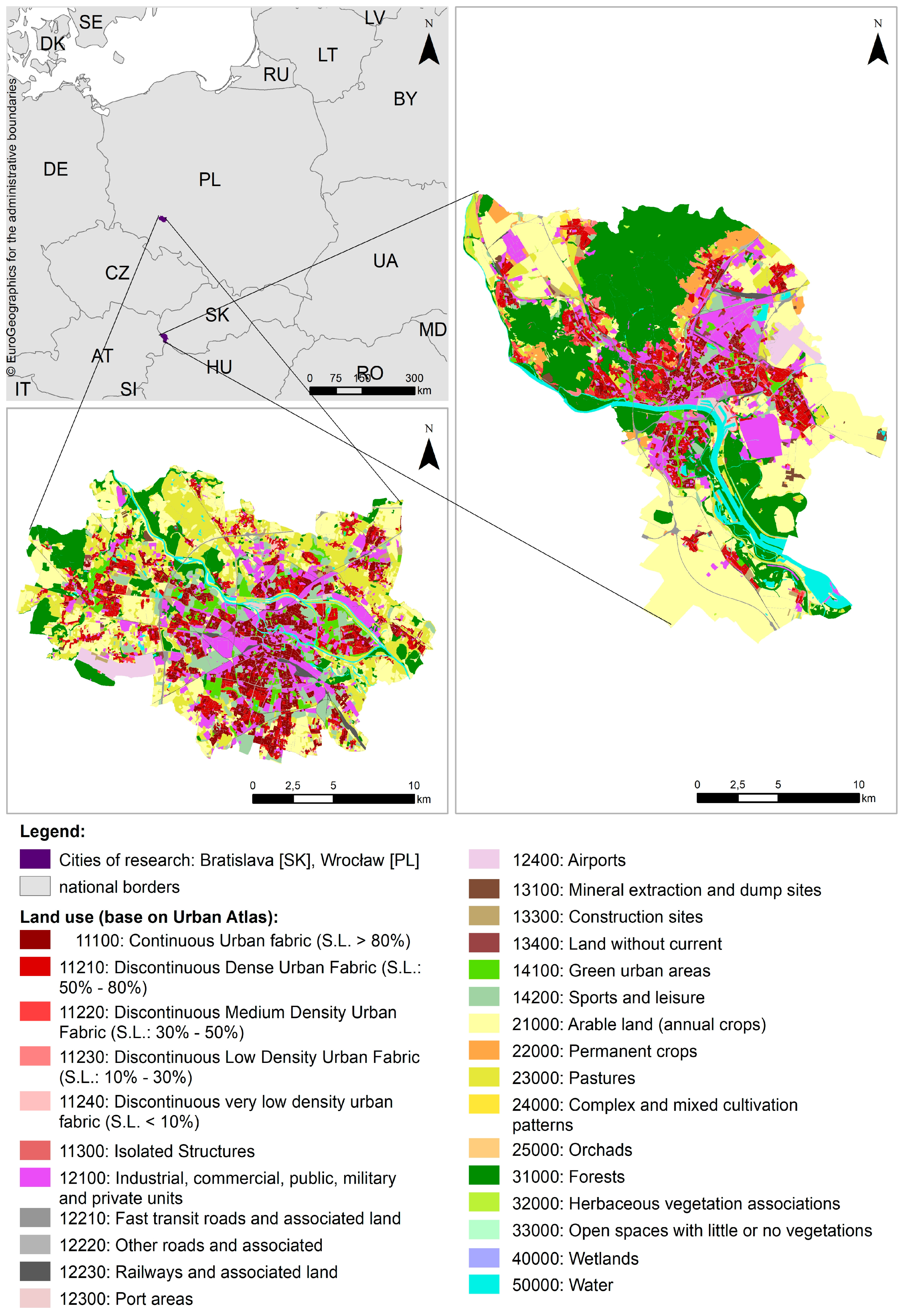
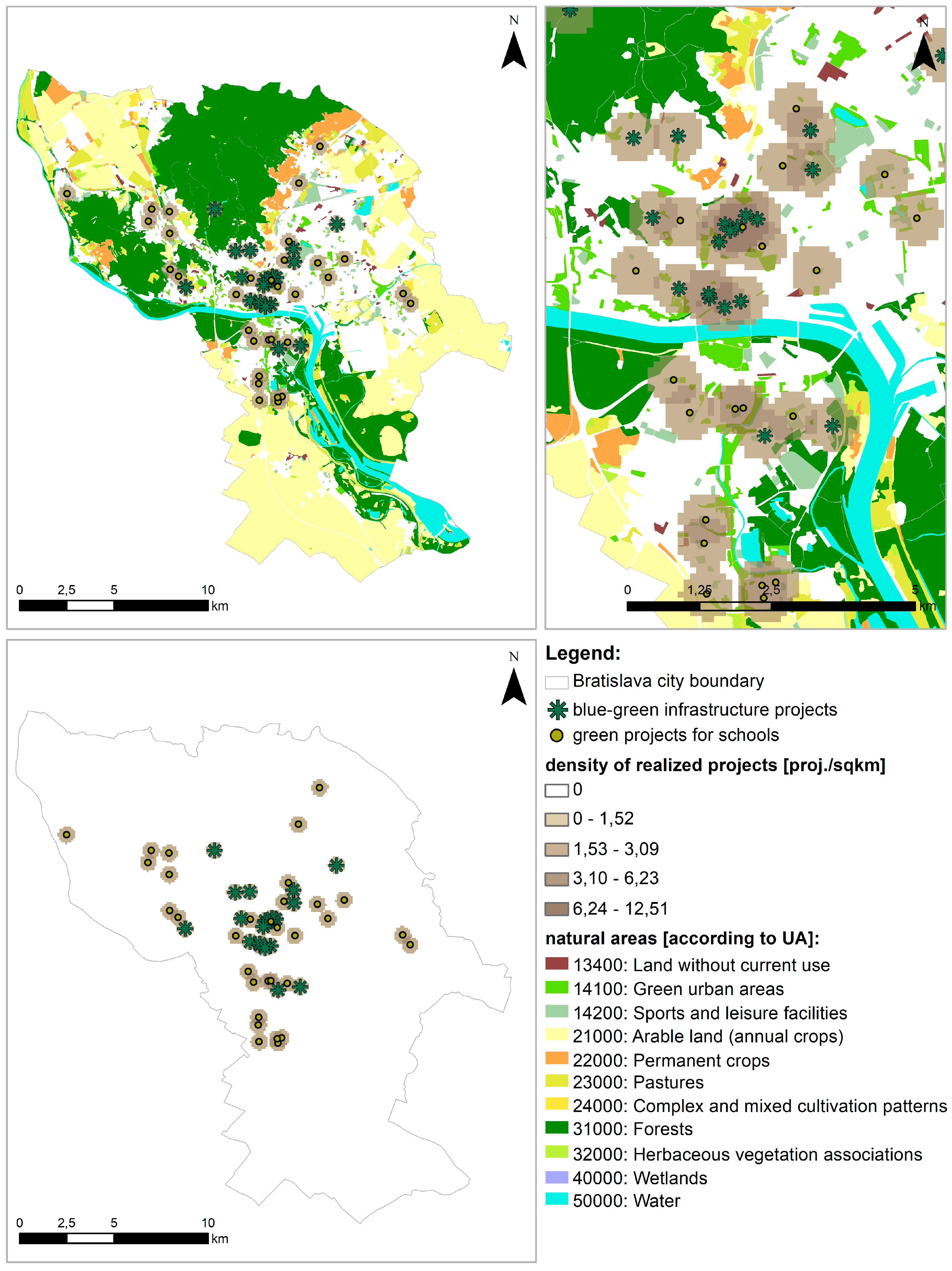
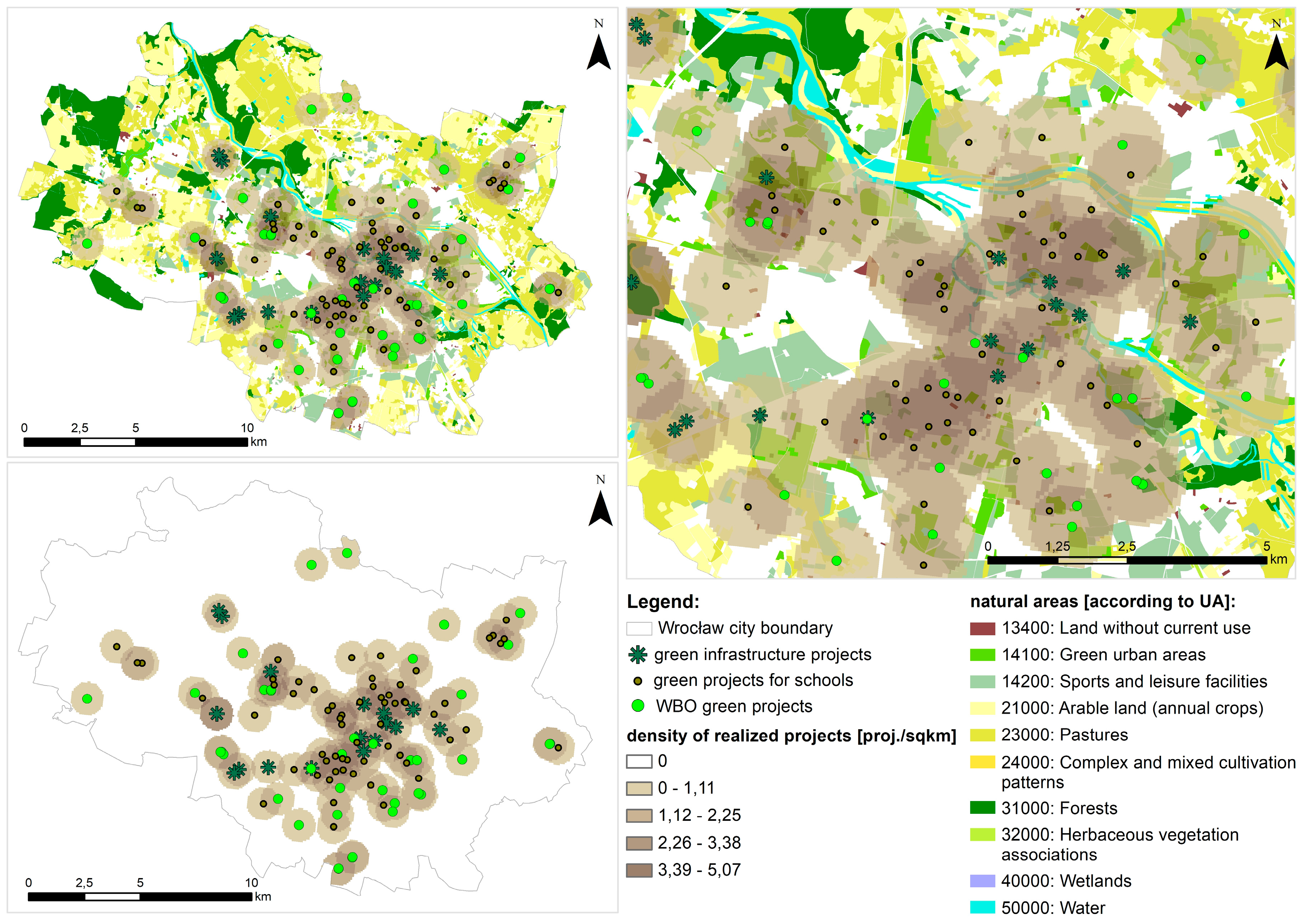
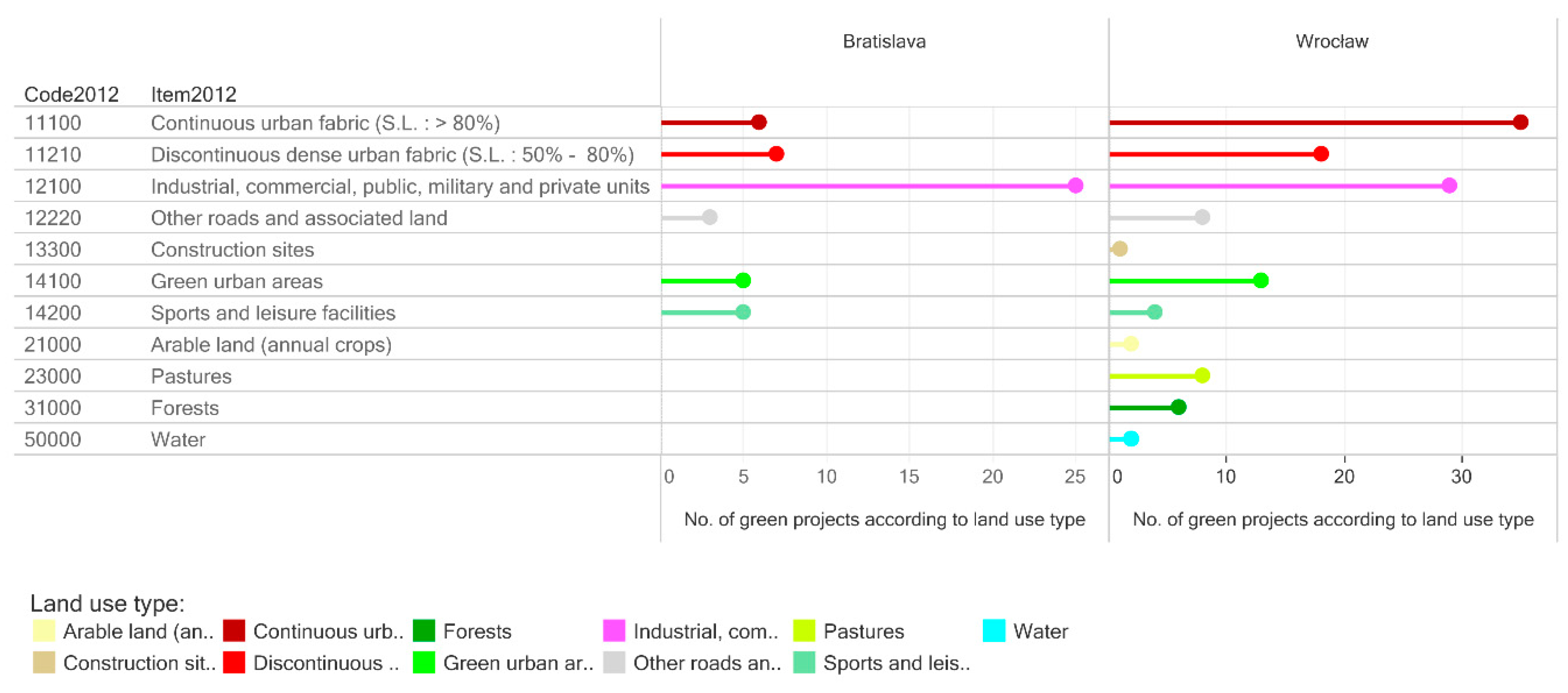
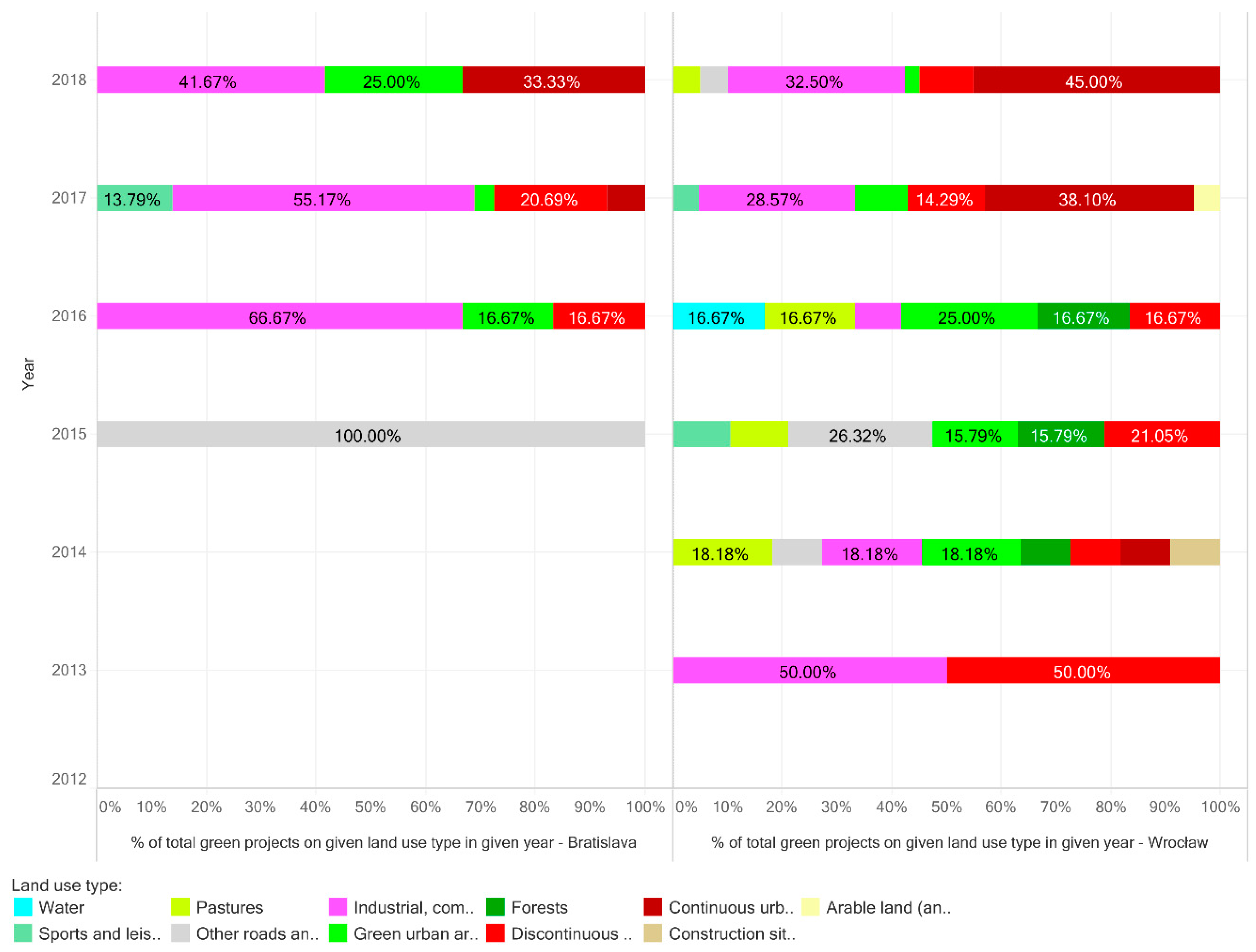
| Formal Aspects | Bratislava | Wrocław |
|---|---|---|
| STRATEGY (POLICY DOCUMENTS) |
|
|
| PROGRAMS AND PLANS |
|
|
| Solutions | Bratislava | Wrocław |
|---|---|---|
| Practical |
|
|
| Educational |
|
|
| Participatory |
|
|
© 2019 by the authors. Licensee MDPI, Basel, Switzerland. This article is an open access article distributed under the terms and conditions of the Creative Commons Attribution (CC BY) license (http://creativecommons.org/licenses/by/4.0/).
Share and Cite
Belčáková, I.; Świąder, M.; Bartyna-Zielińska, M. The Green Infrastructure in Cities as A Tool for Climate Change Adaptation and Mitigation: Slovakian and Polish Experiences. Atmosphere 2019, 10, 552. https://doi.org/10.3390/atmos10090552
Belčáková I, Świąder M, Bartyna-Zielińska M. The Green Infrastructure in Cities as A Tool for Climate Change Adaptation and Mitigation: Slovakian and Polish Experiences. Atmosphere. 2019; 10(9):552. https://doi.org/10.3390/atmos10090552
Chicago/Turabian StyleBelčáková, Ingrid, Małgorzata Świąder, and Małgorzata Bartyna-Zielińska. 2019. "The Green Infrastructure in Cities as A Tool for Climate Change Adaptation and Mitigation: Slovakian and Polish Experiences" Atmosphere 10, no. 9: 552. https://doi.org/10.3390/atmos10090552
APA StyleBelčáková, I., Świąder, M., & Bartyna-Zielińska, M. (2019). The Green Infrastructure in Cities as A Tool for Climate Change Adaptation and Mitigation: Slovakian and Polish Experiences. Atmosphere, 10(9), 552. https://doi.org/10.3390/atmos10090552







